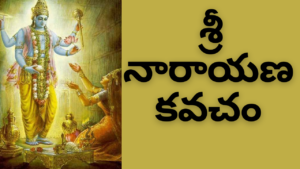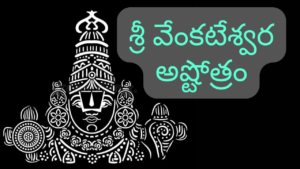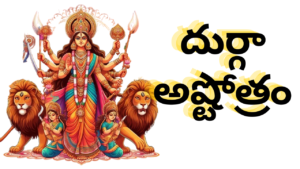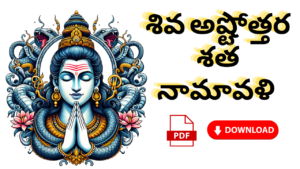Dattatreya Stotram in Telugu : The Dattatreya Stotram in Telugu is a revered hymn dedicated to Lord Dattatreya, a divine figure in Hinduism known for embodying the trinity of Brahma, Vishnu, and Shiva
శ్రీ దత్తాత్రేయ స్తోత్రం
జటాధరం పాండురాంగం శూలహస్తం కృపానిధిమ్ ।
సర్వరోగహరం దేవం దత్తాత్రేయమహం భజే ॥ 1 ॥
అస్య శ్రీదత్తాత్రేయస్తోత్రమంత్రస్య భగవాన్నారదృషిః । అనుష్టుప్ ఛందః । శ్రీదత్తః పరమాత్మా దేవతా । శ్రీదత్తాత్రేయ ప్రీత్యర్థే జపే వినియోగః ॥
నారద ఉవాచ ।
జగదుత్పత్తికర్త్రే చ స్థితిసంహారహేతవే ।
భవపాశవిముక్తాయ దత్తాత్రేయ నమోఽస్తు తే ॥ 1 ॥
జరాజన్మవినాశాయ దేహశుద్ధికరాయ చ ।
దిగంబర దయామూర్తే దత్తాత్రేయ నమోఽస్తు తే ॥ 2 ॥
కర్పూరకాంతిదేహాయ బ్రహ్మమూర్తిధరాయ చ ।
వేదశాస్త్రపరిజ్ఞాయ దత్తాత్రేయ నమోఽస్తు తే ॥ 3 ॥
హ్రస్వదీర్ఘకృశస్థూలనామగోత్రవివర్జిత ।
పంచభూతైకదీప్తాయ దత్తాత్రేయ నమోఽస్తు తే ॥ 4 ॥
యజ్ఞభోక్తే చ యజ్ఞాయ యజ్ఞరూపధరాయ చ ।
యజ్ఞప్రియాయ సిద్ధాయ దత్తాత్రేయ నమోఽస్తు తే ॥ 5 ॥
ఆదౌ బ్రహ్మా హరిర్మధ్యే హ్యంతే దేవస్సదాశివః ।
మూర్తిత్రయస్వరూపాయ దత్తాత్రేయ నమోఽస్తు తే ॥ 6 ॥
భోగాలయాయ భోగాయ యోగయోగ్యాయ ధారిణే ।
జితేంద్రియ జితజ్ఞాయ దత్తాత్రేయ నమోఽస్తు తే ॥ 7 ॥
దిగంబరాయ దివ్యాయ దివ్యరూపధరాయ చ ।
సదోదితపరబ్రహ్మ దత్తాత్రేయ నమోఽస్తు తే ॥ 8 ॥
జంబూద్వీపే మహాక్షేత్రే మాతాపురనివాసినే ।
జయమాన సతాం దేవ దత్తాత్రేయ నమోఽస్తు తే ॥ 9 ॥
భిక్షాటనం గృహే గ్రామే పాత్రం హేమమయం కరే ।
నానాస్వాదమయీ భిక్షా దత్తాత్రేయ నమోఽస్తు తే ॥ 10 ॥
బ్రహ్మజ్ఞానమయీ ముద్రా వస్త్రే చాకాశభూతలే ।
ప్రజ్ఞానఘనబోధాయ దత్తాత్రేయ నమోఽస్తు తే ॥ 11 ॥
అవధూత సదానంద పరబ్రహ్మస్వరూపిణే ।
విదేహదేహరూపాయ దత్తాత్రేయ నమోఽస్తు తే ॥ 12 ॥
సత్యరూప సదాచార సత్యధర్మపరాయణ ।
సత్యాశ్రయపరోక్షాయ దత్తాత్రేయ నమోఽస్తు తే ॥ 13 ॥
శూలహస్తగదాపాణే వనమాలాసుకంధర ।
యజ్ఞసూత్రధర బ్రహ్మన్ దత్తాత్రేయ నమోఽస్తు తే ॥ 14 ॥
క్షరాక్షరస్వరూపాయ పరాత్పరతరాయ చ ।
దత్తముక్తిపరస్తోత్ర దత్తాత్రేయ నమోఽస్తు తే ॥ 15 ॥
దత్త విద్యాఢ్య లక్ష్మీశ దత్త స్వాత్మస్వరూపిణే ।
గుణనిర్గుణరూపాయ దత్తాత్రేయ నమోఽస్తు తే ॥ 16 ॥
శత్రునాశకరం స్తోత్రం జ్ఞానవిజ్ఞానదాయకమ్ ।
సర్వపాపం శమం యాతి దత్తాత్రేయ నమోఽస్తు తే ॥ 17 ॥
ఇదం స్తోత్రం మహద్దివ్యం దత్తప్రత్యక్షకారకమ్ ।
దత్తాత్రేయప్రసాదాచ్చ నారదేన ప్రకీర్తితమ్ ॥ 18 ॥
ఇతి శ్రీనారదపురాణే నారదవిరచితం శ్రీ దత్తాత్రేయ స్తోత్రమ్ ।
Table of Contents
Dattatreya Stotram in Telugu:
Introduction
The Dattatreya Stotram in Telugu is a revered hymn dedicated to Lord Dattatreya, a divine figure in Hinduism known for embodying the trinity of Brahma, Vishnu, and Shiva. The stotra, or hymn, is a vital part of the spiritual practice for many devotees, especially in regions where Telugu is spoken. This article delves into the significance of the Dattatreya Stotram, its benefits, and provides answers to frequently asked questions to help devotees deepen their understanding and practice.
The Significance of Dattatreya Stotram
Who is Lord Dattatreya?
Lord Dattatreya is a unique deity in Hinduism who represents the combined essence of the supreme trinity: Brahma the creator, Vishnu the preserver, and Shiva the destroyer. His teachings emphasize the importance of self-realization and the path to liberation. As an embodiment of these three principal deities, Dattatreya is revered for his wisdom, compassion, and power.
What is the Dattatreya Stotram?
The Dattatreya Stotram is a devotional hymn that praises Lord Dattatreya. It is a key element in the worship and veneration of this deity. The hymn is typically composed in Sanskrit, but many versions are available in regional languages like Telugu, making it accessible to a broader audience. The Telugu version of the Dattatreya Stotram retains the essence of the original while presenting it in a language familiar to many devotees.
Benefits of Chanting the Dattatreya Stotram in Telugu
Spiritual Benefits
- Enhances Devotion: Reciting the Dattatreya Stotram in Telugu helps devotees connect deeply with the deity. The familiar language allows for a more personal and profound devotional experience.
- Promotes Peace of Mind: The hymn’s soothing and rhythmic nature can calm the mind, reduce stress, and promote inner peace.
- Boosts Spiritual Growth: Regular chanting of the stotra is believed to foster spiritual growth and enlightenment by aligning the devotee’s energies with divine vibrations.
Practical Benefits
- Improves Focus: The practice of reciting the Dattatreya Stotram in Telugu can enhance concentration and mental clarity.
- Cultivates Discipline: Regular recitation requires and fosters discipline, which can translate into other areas of life.
- Strengthens Faith: Engaging with the hymn in one’s native language can strengthen faith and deepen the devotee’s relationship with Lord Dattatreya.
How to Recite the Dattatreya Stotram in Telugu
Finding the Right Text
The first step is to obtain a reliable version of the Dattatreya Stotram in Telugu. Many temples and spiritual bookstores offer these texts, and online resources can also be useful. Ensure that the text is accurate and respected in the devotional community.
Learning the Correct Pronunciation
Proper pronunciation is crucial for effective recitation. While the Telugu script may be familiar, the correct articulation of each syllable and verse is important for the hymn’s spiritual potency. Many online platforms offer audio resources or tutorials to help with pronunciation.
Setting Up a Sacred Space
Create a serene and sacred space for your recitation practice. This can be a small altar or a quiet corner of your home where you can focus solely on the hymn.
Regular Practice
Consistency is key to experiencing the full benefits of chanting. Set aside a specific time each day for reciting the Dattatreya Stotram. Early morning or evening is often recommended for spiritual practices.
Frequently Asked Questions (FAQs)
What is the origin of the Dattatreya Stotram?
The Dattatreya Stotram is a devotional hymn composed in praise of Lord Dattatreya. Its origins are rooted in ancient Hindu scriptures, and it has been passed down through generations of devotees. While the original hymns are in Sanskrit, various regional languages, including Telugu, have translations to make the hymn more accessible.
Can beginners chant the Dattatreya Stotram in Telugu?
Yes, beginners can chant the Dattatreya Stotram. It is recommended to start with a simplified version or listen to recitations to get familiar with the verses. Over time, as you become more comfortable, you can deepen your practice.
How long should one chant the Dattatreya Stotram each day?
There is no fixed duration for chanting the Dattatreya Stotram. However, it is beneficial to recite it daily for at least 10 to 15 minutes. The key is consistency and sincerity in your practice.
Are there specific times that are best for chanting the Dattatreya Stotram?
Traditionally, early morning (Brahma Muhurta) and evening (Sandhya) are considered auspicious times for chanting. These times are believed to be spiritually potent, conducive to meditation, and conducive to a deeper connection with the divine.
What are the common challenges faced while chanting the Dattatreya Stotram?
Common challenges include incorrect pronunciation, difficulty in understanding the meaning, and maintaining consistency. Overcoming these challenges involves practice, guidance from knowledgeable sources, and a genuine intention to connect with Lord Dattatreya.
Can the Dattatreya Stotram be recited in other languages?
Yes, the Dattatreya Stotram can be recited in various languages. While the original is in Sanskrit, translations in languages such as Telugu, Tamil, Kannada, and others make it accessible to a broader audience. The essence and devotion remain intact across different languages.
Conclusion
The Dattatreya Stotram in Telugu holds a special place in the hearts of many devotees, offering a profound way to connect with Lord Dattatreya. By understanding its significance, benefits, and the proper way to recite it, you can enhance your spiritual practice and experience greater devotion and peace. Regular chanting, coupled with a sincere heart, can lead to significant spiritual growth and a deeper connection with the divine.
If you have further questions or need additional resources, many spiritual communities and online platforms are available to support your journey. Embrace the practice with devotion, and let the Dattatreya Stotram guide you on a path of spiritual fulfillment.























